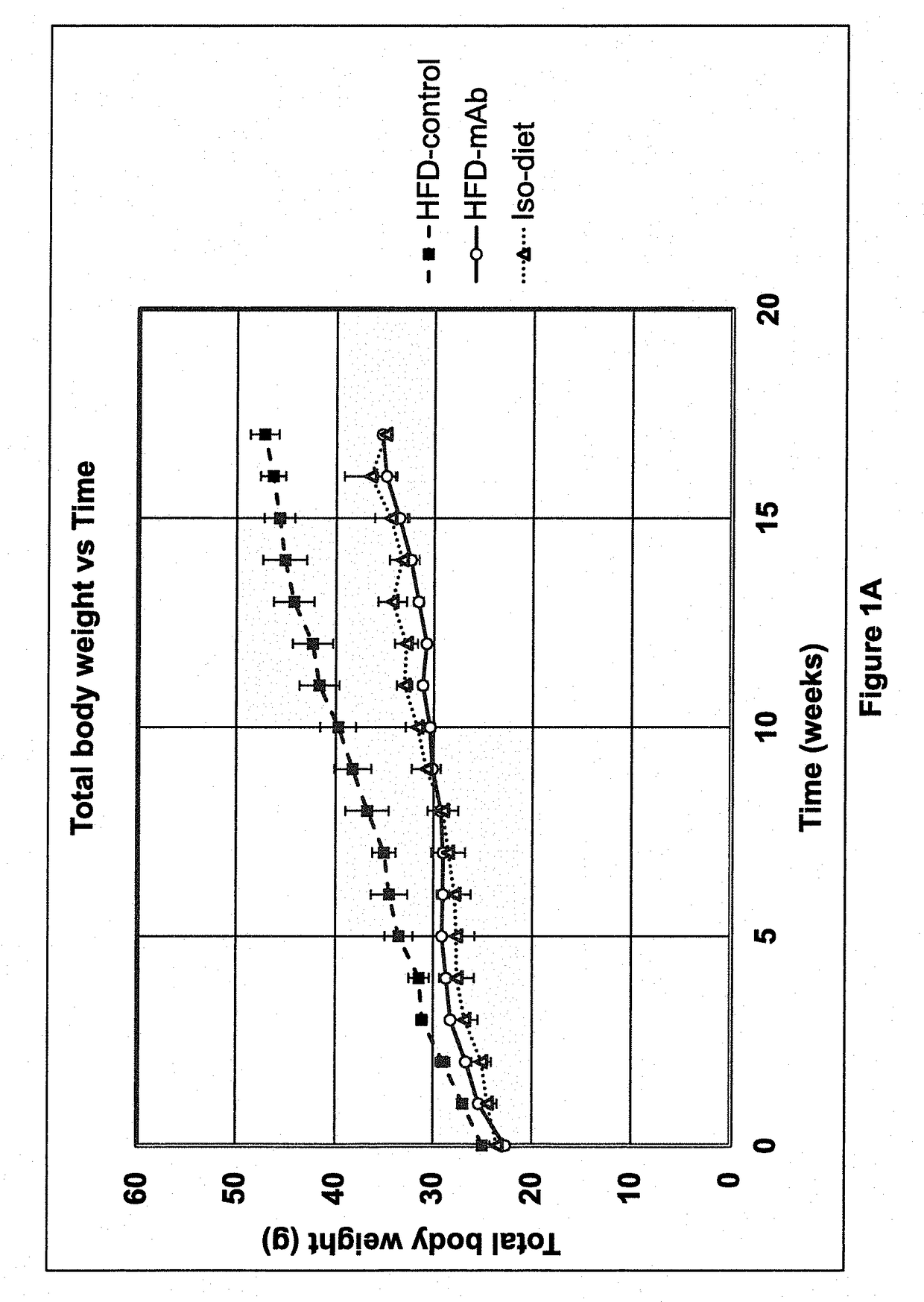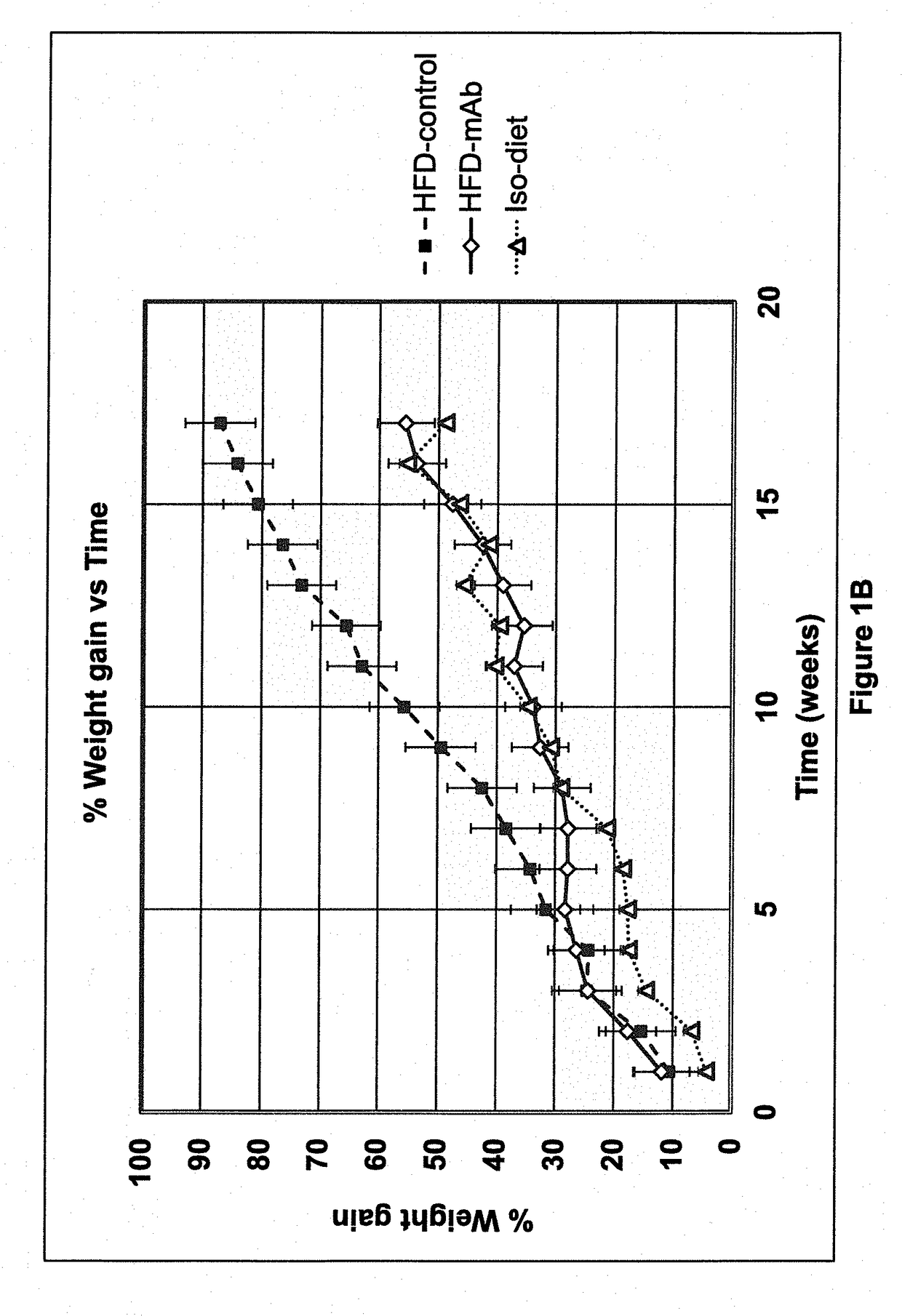Compositions and methods for treating obesity and hyperphagia
a hyperphagia and composition technology, applied in the field of compositions and methods for treating obesity and hyperphagia, can solve the problems of negative health effects, increased risk of metabolic syndrome, and possible psychiatric illnesses, and high blood sugar levels persist over a prolonged period
- Summary
- Abstract
- Description
- Claims
- Application Information
AI Technical Summary
Benefits of technology
Problems solved by technology
Method used
Image
Examples
example 1
[0129]Monoclonal antibodies were generated and screened as described above using hybridomas to identify a monoclonal antibody having high binding affinity for gastric inhibitory peptide (GIP) in suspension. The 10g10 monoclonal antibody was thus identified.
[0130]The 10g10 light chain variable domain has the amino acid sequence of SEQ ID NO: 16. The first CDR of the light chain variable domain has the amino acid sequence of SEQ ID NO: 25. The second CDR of the light chain variable domain has the amino acid sequence of SEQ ID NO: 26. The third CDR of the light chain variable domain has the amino acid sequence of SEQ ID NO: 22. cDNA encoding for the 10g10 light chain variable domain has the nucleotide sequence of SEQ ID NO: 35.
[0131]The 10g10 heavy chain variable domain has the amino acid sequence of SEQ ID NO: 27. The first CDR of the heavy chain variable domain has the amino acid sequence of SEQ ID NO: 31. The second CDR of the heavy chain variable domain has the amino acid sequence ...
example 2
[0134]Materials and Methods
[0135]30 nine-week old male C57BL / 6 mice were purchased from Jackson Laboratories (Bar Harbor, Me.). On the first day of the study, each mouse weighed between 19 and 25 grams. The mice were then subsequently divided at random into three groups of 10 mice each.
[0136]All mice had free access to food and water throughout the study. The mice were all housed in an animal facility kept at 22±2° Celsius with a 12-hour light / 12-hour dark cycle. Mice were housed in groups of five per cage until they each reached a weight of 25 grams. Mice were then subsequently housed two to three animals per cage.
[0137]A high-fat diet (HFD) (catalog no. TD.06414) and a low-fat isocaloric diet (catalog no. TD.08806) were purchased from Harlan-Teklad (Indianapolis, Ind.). The HFD consisted, by weight, of approximately 23.5% protein, 27.3% carbohydrates and 34.3% fat. The HFD provided 18.4% of total calories from protein, 21.3% from carbohydrates, and 60.3% from fat, and 5.1 kcal / gra...
example 3
ion of Antibodies
[0177]The light chain variable region of the 10g10 mAb was further modified by substituting specific amino acids conserved in mouse antibodies with specific amino acids conserved in human antibodies. This was done to “humanize” the light chain variable region to make it more similar to a human variable region, and increase the chance that the human immune system would not recognize the “humanized” mAb as a foreign substance. To humanize the light chain variable region, oligonucleotides were chemically synthesized. The sequences of the oliogonucleotides were similar to the sequence of the 10g10 mAb light chain variable region, except specific bases were changed. The base pairs changed were predicted to change specific amino acids of the light chain variable region when the sequence was translated into protein. A DNA synthesis reaction was used to produce double-stranded (ds) DNA. Three different ds-oligonucleotides were synthesized and then digested with the restrict...
PUM
| Property | Measurement | Unit |
|---|---|---|
| Fraction | aaaaa | aaaaa |
| Fraction | aaaaa | aaaaa |
| Fraction | aaaaa | aaaaa |
Abstract
Description
Claims
Application Information
 Login to View More
Login to View More - R&D
- Intellectual Property
- Life Sciences
- Materials
- Tech Scout
- Unparalleled Data Quality
- Higher Quality Content
- 60% Fewer Hallucinations
Browse by: Latest US Patents, China's latest patents, Technical Efficacy Thesaurus, Application Domain, Technology Topic, Popular Technical Reports.
© 2025 PatSnap. All rights reserved.Legal|Privacy policy|Modern Slavery Act Transparency Statement|Sitemap|About US| Contact US: help@patsnap.com



